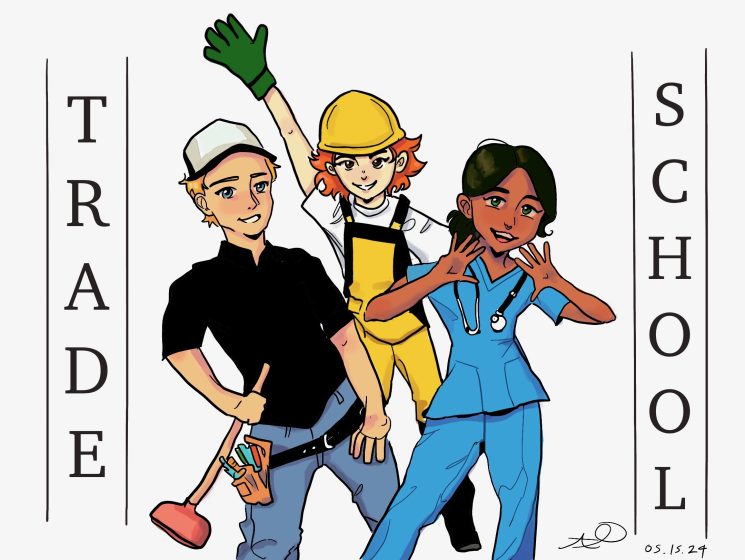
By Christine Garcia
Are you an inspiring electrician, carpenter or nurse? There is not only one pathway to specialize in these fields. Most people often take the path of going to a four-year college. However, many consider other options such as the military, apprenticeships and gap years.
And, less talked about — trade schools. But why don’t we have more conversations about trade schools? What do trade schools have to offer?
The difference between trade schools and four-year colleges
A trade school is a program that offers highly focused training programs for students to assimilate into their specific careers. These vocational programs prepare students for the knowledge and expertise needed to adapt to their subject areas. In addition, trade schools commonly feed into an apprenticeship program, a mixture of work-based training and education, with a guaranteed job after college.
In contrast, four-year institutions are programs that can grant bachelor’s degrees, associate degrees, master’s degrees and doctoral degrees. They typically offer academic programs that allow students to explore many fields of study.
When weighing the differences, vocational schools are classified as businesses, whereas most four-year colleges are non-profits. Universities can receive funding and distribute profits to students. With the finances, universities can enhance their students’ education by hiring new staff or creating new programs.
Moreover, some trade schools are for-profit, meaning that the purpose of their organization is to make money for a private company. Hence, for some trade schools, a student may not be able to use financial aid to cover the costs.
Some disadvantages of for-profit organizations include high fees, uncredited programs, reduced job opportunities and low quality of education. Since some trade schools are not accredited, it may affect students’ abilities to get a job, if an employer doesn’t acknowledge their credentials. This is why guidance staff at Fountain Valley High School (FVHS) typically don’t mention trade schools to students as a viable option.
“We never want to recommend students to places that are going to cost them money; we don’t necessarily know if you’re getting what you’re paying for. So that’s why trade school is never really part of our talk in terms of recommendations,” FVHS guidance specialist Lindsey Gonzalez said.
Trade school isn’t a subject area where FVHS’s specialists are specialized, so they are more involved in other pathways. However, if a student chooses the trade school pathway, the guidance staff would be more than willing to support the student.
Keep in mind that this information does not apply to all trade schools. Let’s look at a couple of trade schools in Orange County.
UEI College
From health care to welding, UEI has a variety of courses that they offer online or in person. Their curriculum includes action-based learning, with smaller classes that focus on student development. Located in Garden Grove, with eight programs and 17 classrooms, UEI offers many opportunities.
Although it is referred to as a college, its website specifies that the programs are vocational. On their website, they reassure their potential students that they collaborate with industry professionals and follow the standard curriculum. Their career training may take less than ten months to complete.
The website also confirms that the Accrediting Commission of Career Schools and Colleges (ACCSC) accredited UEI College as an academic institution. Additionally, UEI accepts specific financial aid that you have to qualify for. However, they don’t specify how much the courses cost.
Brownson Technical School
Brownson Technical School (BTS) is an institution that focuses on heating, air conditioning and refrigeration installation or mechanics (HVAC/R). In Anaheim, they operate in a 12,000-square-foot building with a 1,700-foot testing facility.
They have educators who are credited to be Master Certified HVAC/R. Their students have access to Direct Digital Controls and Building Automation. Aside from that, they accept a limited number of financial aid programs.
Like UEI, BTS confirms that training may take a minimum of ten months and they are recognized as an academic institution by the ACCSC. In addition, BTS stands out for its networking connections to repeatedly ensure employment. In 2015, they confirmed to have an 89% job placement rate.
Cerritos College
Cerritos College is an institution that specializes in woodworking and furniture manufacturing. In Norwalk, Cerritos College educates students in a 27,000-square-foot facility with 100 machines. They express an emphasis on craftsmanship.
They offer an education for $46 per unit, with qualified professors and modern facilities. Students are taught how to handle and fix machines to build furniture.
American Career College
In Anaheim, American Career College focuses on the healthcare industry, with 12 accreditations. They use technology from simulation equipment to real tools for specific careers to educate students. In addition, educators utilize labs and externships to teach their students.
American Career College accepts a limited number of financial aid from federal and state governments. But, they don’t offer financial aid.
Aside from supporting their students academically, they have tutoring and career consulting services to support their students.
Conclusion
In conclusion, trade schools are a valuable alternative to four-year universities. They provide students with the skills and knowledge they need to enter many fields. With the growing need for skilled workers, trade schools play an important role in education.
Consider trade school as an option for career training.





